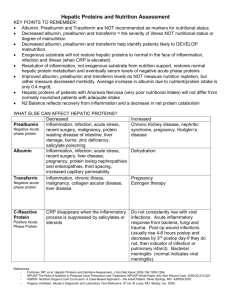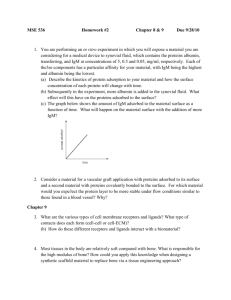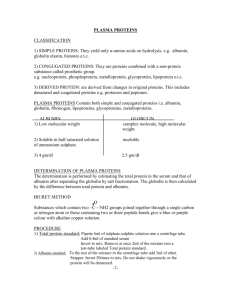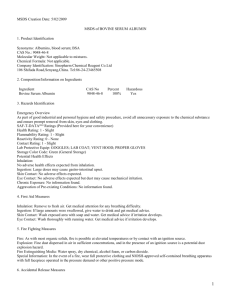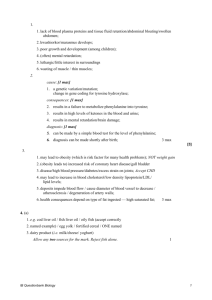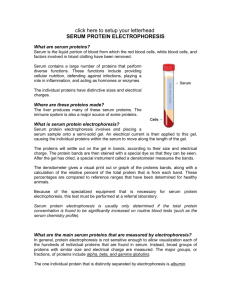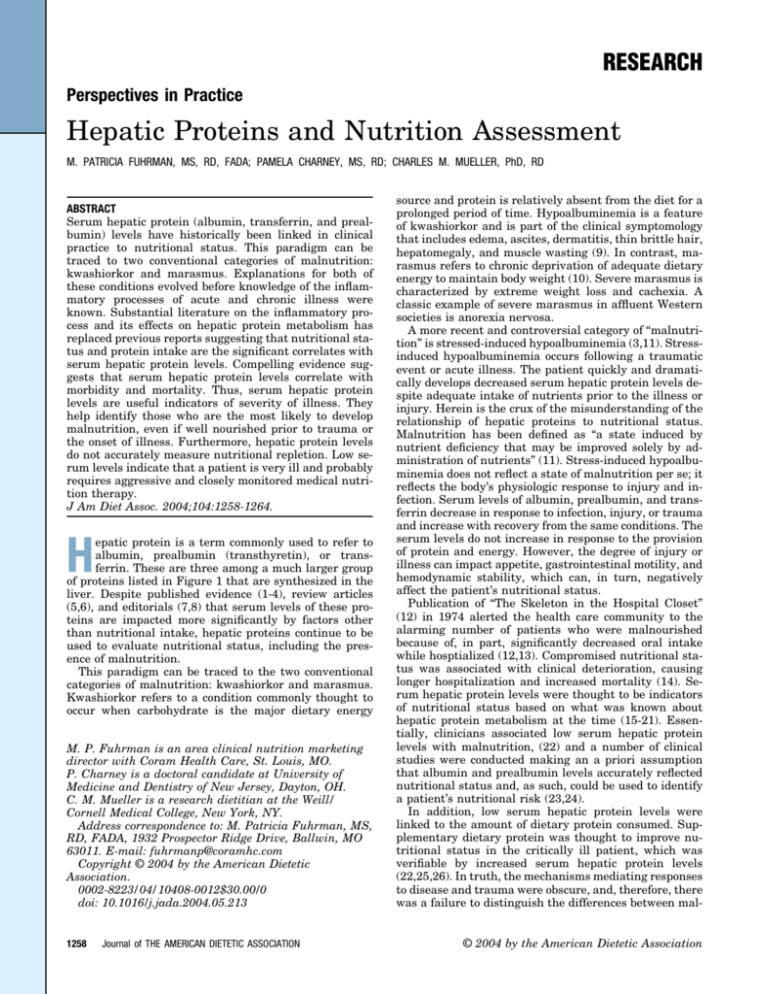
RESEARCH
Perspectives in Practice
Hepatic Proteins and Nutrition Assessment
M. PATRICIA FUHRMAN, MS, RD, FADA; PAMELA CHARNEY, MS, RD; CHARLES M. MUELLER, PhD, RD
ABSTRACT
Serum hepatic protein (albumin, transferrin, and prealbumin) levels have historically been linked in clinical
practice to nutritional status. This paradigm can be
traced to two conventional categories of malnutrition:
kwashiorkor and marasmus. Explanations for both of
these conditions evolved before knowledge of the inflammatory processes of acute and chronic illness were
known. Substantial literature on the inflammatory process and its effects on hepatic protein metabolism has
replaced previous reports suggesting that nutritional status and protein intake are the significant correlates with
serum hepatic protein levels. Compelling evidence suggests that serum hepatic protein levels correlate with
morbidity and mortality. Thus, serum hepatic protein
levels are useful indicators of severity of illness. They
help identify those who are the most likely to develop
malnutrition, even if well nourished prior to trauma or
the onset of illness. Furthermore, hepatic protein levels
do not accurately measure nutritional repletion. Low serum levels indicate that a patient is very ill and probably
requires aggressive and closely monitored medical nutrition therapy.
J Am Diet Assoc. 2004;104:1258-1264.
H
epatic protein is a term commonly used to refer to
albumin, prealbumin (transthyretin), or transferrin. These are three among a much larger group
of proteins listed in Figure 1 that are synthesized in the
liver. Despite published evidence (1-4), review articles
(5,6), and editorials (7,8) that serum levels of these proteins are impacted more significantly by factors other
than nutritional intake, hepatic proteins continue to be
used to evaluate nutritional status, including the presence of malnutrition.
This paradigm can be traced to the two conventional
categories of malnutrition: kwashiorkor and marasmus.
Kwashiorkor refers to a condition commonly thought to
occur when carbohydrate is the major dietary energy
M. P. Fuhrman is an area clinical nutrition marketing
director with Coram Health Care, St. Louis, MO.
P. Charney is a doctoral candidate at University of
Medicine and Dentistry of New Jersey, Dayton, OH.
C. M. Mueller is a research dietitian at the Weill/
Cornell Medical College, New York, NY.
Address correspondence to: M. Patricia Fuhrman, MS,
RD, FADA, 1932 Prospector Ridge Drive, Ballwin, MO
63011. E-mail: fuhrmanp@coramhc.com
Copyright © 2004 by the American Dietetic
Association.
0002-8223/04/10408-0012$30.00/0
doi: 10.1016/j.jada.2004.05.213
1258
Journal of THE AMERICAN DIETETIC ASSOCIATION
source and protein is relatively absent from the diet for a
prolonged period of time. Hypoalbuminemia is a feature
of kwashiorkor and is part of the clinical symptomology
that includes edema, ascites, dermatitis, thin brittle hair,
hepatomegaly, and muscle wasting (9). In contrast, marasmus refers to chronic deprivation of adequate dietary
energy to maintain body weight (10). Severe marasmus is
characterized by extreme weight loss and cachexia. A
classic example of severe marasmus in affluent Western
societies is anorexia nervosa.
A more recent and controversial category of “malnutrition” is stressed-induced hypoalbuminemia (3,11). Stressinduced hypoalbuminemia occurs following a traumatic
event or acute illness. The patient quickly and dramatically develops decreased serum hepatic protein levels despite adequate intake of nutrients prior to the illness or
injury. Herein is the crux of the misunderstanding of the
relationship of hepatic proteins to nutritional status.
Malnutrition has been defined as “a state induced by
nutrient deficiency that may be improved solely by administration of nutrients” (11). Stress-induced hypoalbuminemia does not reflect a state of malnutrition per se; it
reflects the body’s physiologic response to injury and infection. Serum levels of albumin, prealbumin, and transferrin decrease in response to infection, injury, or trauma
and increase with recovery from the same conditions. The
serum levels do not increase in response to the provision
of protein and energy. However, the degree of injury or
illness can impact appetite, gastrointestinal motility, and
hemodynamic stability, which can, in turn, negatively
affect the patient’s nutritional status.
Publication of “The Skeleton in the Hospital Closet”
(12) in 1974 alerted the health care community to the
alarming number of patients who were malnourished
because of, in part, significantly decreased oral intake
while hosptialized (12,13). Compromised nutritional status was associated with clinical deterioration, causing
longer hospitalization and increased mortality (14). Serum hepatic protein levels were thought to be indicators
of nutritional status based on what was known about
hepatic protein metabolism at the time (15-21). Essentially, clinicians associated low serum hepatic protein
levels with malnutrition, (22) and a number of clinical
studies were conducted making an a priori assumption
that albumin and prealbumin levels accurately reflected
nutritional status and, as such, could be used to identify
a patient’s nutritional risk (23,24).
In addition, low serum hepatic protein levels were
linked to the amount of dietary protein consumed. Supplementary dietary protein was thought to improve nutritional status in the critically ill patient, which was
verifiable by increased serum hepatic protein levels
(22,25,26). In truth, the mechanisms mediating responses
to disease and trauma were obscure, and, therefore, there
was a failure to distinguish the differences between mal-
© 2004 by the American Dietetic Association
Positive acute-phase proteins
Complement system
C3
C4
C9
Factor B
C1 inhibitor
C4b-binding protein
Mannose-binding lectin
Coagulation and fibrinolytic system
Fibrinogen
Plasminogen
Tissue plasminogen activator
Urokinase
Protein S
Vitronectin
Plasminogen-activator inhibitor
Antiproteases
␣1-Protease inhibitor
␣1-Antichymotrypsin
Pancreatic secretory trypsin inhibitor
Inter-␣-trypsin inhibitors
Transport proteins
Ceruloplasmin
Haptoglobulin
Hemopexin
Participants in inflammatory responses
Secreted phospholipase A2
Lipopolysaccharide-binding protein
Interleukin-1-receptor antagonist
Granulocyte colony-stimulating factor
Others
C-reactive protein
Serum amyloid A
␣1-Acid glycoprotein
Fibronectin
Ferritin
Angiotensinogen
Negative acute-phase proteins
Albumin
Transferrin
Transthyretin (prealbumin)
␣2-HS glycoprotein
Alpha-fetoprotein
Thyroxin-binding globulin
Insulin-like growth factor I
Factor XII
is to propose the most appropriate role for hepatic proteins in the nutrition assessment process.
KWASHIORKOR AND MARASMUS
The term kwashiorkor was first used to describe what
was thought to be a form of malnutrition observed in
young children from underdeveloped areas of the world.
Health care experts associated early weaning from human milk to a protein-deficient oral diet, consisting
mainly of grain-based foods, with kwashiorkor. Children
presented with hypoalbuminemia; edema of the extremities, lower back, and face; fatty liver; and anorexia (9,27).
To date, this condition has not been observed in adults or
children in industrialized areas of the world.
Kwashiorkor has been theoretically ascribed to diets
composed almost exclusively of carbohydrate, causing
high insulin levels, which diminish the rate of protein
and fat oxidation. The relative absence of protein in the
diet leads to inadequate amounts and altered ratios of
amino acid substrate for protein synthesis. Hypoalbuminemia causes a reduction in colloid oncotic pressure in the
vascular space and subsequent extravascular fluid accumulation, which presents as edema and ascites (28). However, the impact of a severely protein-deficient diet on
serum albumin is neither immediate nor dramatic. Two
weeks of a severely protein-deficient diet is necessary to
demonstrate a 10% reduction in serum albumin levels
(29,30).
In fact, protein deficiency may not be the causative
factor of kwashiorkor. Studies using a low-protein diet in
healthy volunteers and animals have failed consistently
to produce kwashiorkor (31). Furthermore, kwashiorkor
in breastfed infants who received adequate protein from
maternal milk despite poor maternal diet failed to support conventional causation theory (32).
Alternative etiologies include infections, aflatoxin poisoning (33), and oxidative stress (34). The relationship
between pediatric infectious diarrhea and kwashiorkorlike malnutrition is fairly well known (35). Chronic ingestion of aflatoxin, a toxin produced by mold growing on
grain products in hot and humid climates, may have
Increase
Intravascular volume deficit
Exogenous albumin infusion
Renal failure
Iron deficiencya
Figure 1. Human acute-phase proteins. (Reprinted with permission
from reference 1: Gabay C, Kushner I. Acute-phase proteins and other
systemic responses to inflammation. N Engl J Med. 1999;340:448-454.
Copyright © 1999 Massachusetts Medical Society. All rights reserved.)
nutrition caused by nutrient deficiency and physiologic
changes caused by disease and trauma.
The purposes of this article are threefold. The first is to
discuss kwashiorkor, marasmus, and hepatic protein metabolism in both normal health and inflammation associated with disease or trauma. The second is to review
critically the literature that suggests serum hepatic protein levels correlate with nutritional status and, more
significantly, acuity of illness or trauma. The last purpose
a
Decrease
Intravascular volume excess
Recumbent posture
Extraneous loss of albumin
Liver disease
Pregnancy
Hypothyroid
Alcohol abuse
Nephrotic syndrome
Uremia
Corticosteroids
Malignancy
Trauma (including surgery)
Inflammation
Transferrin only.
Figure 2. Factors that impact serum levels of albumin, prealbumin,
and transferrin. (Developed from references 26, 40, 41, and 43.)
Journal of THE AMERICAN DIETETIC ASSOCIATION
1259
1260
August 2004 Volume 104 Number 8
Author
Design/method
Seltzer and
colleagues (50)
Case control/Associations between serum
albumin and diagnosis, complications,
mortality, and surgical procedures.
Weinsier and
colleagues (14)
Cohort/Nutritional and clinical status using eight
nutrition-related parameters including serum
albumin were evaluated at admission and
after 2 weeks’ hospitalization.
Descriptive, population-based point in time/Body
composition was compared with serum
albumin levels on or before starting PNb.
Forse and Shizgal
(48)
Population
sample size
N⫽500,
consecutive
hospital
admissions.
N⫽134,
consecutive
hospital
admissions.
N⫽102,
hospitalized
patients.
Anderson and
Wochos (51)
Cohort/Albumin, anthropometrics and %IBWc
correlated with LOS.
Sganga and
colleagues (2)
Cohort/Serum hepatic protein levels monitored
postinjury during sepsis.
N⫽47, hospitalized
nephrology
patients.
N⫽26, severely
injured patients.
Boosalis and
colleagues (52)
Cohort/Relationships of hepatic proteins and
mortality and morbidity.
N⫽78, critically ill
patients.
McClave and
colleagues (3)
Case control/Costs, morbidity and mortality were
compared with either marasmic or
hypoalbuminemic protein calorie malnutrition.
N⫽180, PN
patients for 12month period.
Ballmer and
colleagues (53)
Quasi-experimental/Albumin synthesis and
nitrogen balance before and during two levels
of induced metabolic acidosis.
N⫽8, healthy adult
males.
Sreedhara and
colleagues (54)
Cohort/Baseline prealbumin and albumin levels
were compared with mortality at 5 years.
N⫽111, chronic
hemodialysis and
78, peritoneal
dialysis
outpatients.
Results
Comments
Hypoalbuminemia significantly associated with
fourfold increase in morbidity and a sixfold
increase in mortality.
Albumin is a prognostic
indicator.
Hypoalbuminemia and decreased hematocrit
correlated with increased LOSa. Serum
albumin decreased with longer hospitalization.
Subjects with decreased
serum albumin levels
had longer LOS.
Significant correlation between albumin and
body composition, but serum albumin neither
specific nor sensitive: 44% of normally
nourished patients were hypoalbuminemic;
11.2% of malnourished patients had normal
serum albumin levels. No correlation between
body cell mass and albumin.
Hypoalbuminemia associated with longer LOS.
Low albumin-associated infections.
Serum protein levels
have poor specificity
and sensitivity.
Serum albumin did
not correlate with
body cell mass.
C-reactive protein, fibrinogen, ceruloplasmin,
and ␣1-antitrypsin levels increased and
albumin, transferrin, and ␣2-macroglobulin
levels decreased with injury and sepsis.
Admission albumin and prealbumin decreased in
all patients. Albumin and prealbumin
significantly lower in nonsurvivors. Prealbumin
levels recovered sooner than albumin. Creactive protein elevated in injured patients.
Hypoalbuminemic protein calorie malnutrition
(defined by the presence of abnormal levels
of three of the following: albumin, transferrin,
prealbumin, and TLCd) resulted in increased
LOS, cost, morbidity, and mortality.
Both groups lost weight despite 2,800 kcal/d.
Significantly decreased albumin in the highdose group. Nitrogen loss greater in the highdose group.
Low prealbumin (⬍30 g/L) correlated with
mortality in both patient groups. Albumin ⬍35
g/L associated with increased mortality in
peritoneal dialysis patients.
Hypoalbuminemia
associated with
morbidity.
Effects of injury and
sepsis on hepatic
protein metabolism.
Albumin and prealbumin
as prognostic
indicators.
Decreased albumin,
transferrin,
prealbumin, and TLC
associated with
increased cost,
morbidity, and
mortality.
Morbidity rather than
nutrition affects
albumin levels.
Relationships between
hepatic proteins and
mortality.
Albumin, prealbumin
TLC, and body
composition are not
responsive to energy
balance in critical
illness.
Normalization of hepatic
protein metabolism is
independent of
normal total body
protein metabolism in
the postinjury phase.
LOS⫽length of hospital stay.
PN⫽parenteral nutrition.
c
IBW⫽ideal body weight.
d
TLC⫽total lymphocyte count.
b
a
Cohort/Relationships between energy balance
and fluid status, weight, serum albumin,
prealbumin, TLC, body cell mass, extracellular
fluid, body fat, and mortality.
Phang and
Aeberhardt (49)
N⫽45, critically ill
patients.
Figure 3. Hepatic proteins in acute, chronic, and critical illness.
Insulin-like growth factor-1, prealbumin, and
transferrin decreased and C-reactive protein and
␣1-antitrypsin levels increased early
postdisease/injury. During recovery, hepatic
protein levels returned to normal despite
continued proteolysis and increased energy
expenditure.
At 7 days, significant changes in weight, serum
albumin and prealbumin, and extracellular mass
did not correlate with energy or fluid balance. At
3 weeks, significant changes in weight,
prealbumin, and extracellular mass did not
correlate with energy balance. Albumin did not
correlate with fluid balance. Significant
correlation between weight and extracellular
mass and fluid balance. No significant change
in TLC, body cell mass, or body fat.
N⫽24, critically ill
patients
admitted during
a 12-month
period.
Case series/Hepatic proteins and insulin-like
growth factor-1 were measured at 5, 10, 15,
and 21 days after patients were
hemodynamically stable. Magnitude and
direction of hepatic protein metabolism
compared with total body protein metabolism.
Clark and colleagues
(45)
adverse effects on hepatic metabolism (36). Oxidative
stress may contribute to kwashiorkor symptoms by virtue
of oxidative damage to proteins (37). Thus, very lowprotein diets may not be the cause of hypoalbuminemia in
pediatric populations in underdeveloped countries.
In contrast, marasmus is caused by long-term inadequate intake of all macronutrients. During short-term
starvation, homeostatic mechanisms maintain glucose
supply to glucose-requiring tissues by utilizing musclederived amino acid substrate for gluconeogenesis. Continuous muscle protein catabolism for gluconeogenic substrate can cause death. The process is abated by
increased utilization of fatty acids for oxidative substrate
and from oxidation of ketones derived from fatty acid
oxidation. In this manner, muscle protein is “spared.”
Protein catabolism continues, albeit at a slow rate, to
provide obligatory glucose requirements. Death from marasmus is usually caused by loss of respiratory muscle
function and subsequent respiratory failure. In the case
of marasmus, serum hepatic protein levels are not affected by inadequate nutrient intake in that synthesis of
hepatic proteins is maintained until very late in the process (38).
HEPATIC PROTEINS
The approximate distribution of body protein is 40% in
muscle, 10% in organs, 30% in skin and blood, and 20% in
various other tissues and protein-containing components
(39). Circulating hepatic proteins are part of the blood
compartment. Hepatic proteins are not stored to any extent in the hepatocytes; rather, they are synthesized by
hepatocytes and released into the circulation. Body protein is in a constant state of anabolism (synthesis) and
catabolism (breakdown). The flux of amino acids moving
through this process of turnover is referred to as the
amino acid pool. Amino acids derived from muscle catabolism and dietary intake supply the pool for subsequent
structural (muscle) and functional (hepatic) protein synthesis. When the body’s requirement for protein exceeds
availability, muscle protein is catabolized in deference to
maintaining functional proteins, which include hepatic
proteins (39).
We have adopted the categorization of hepatic proteins
described by Gabay and Kushner (1) outlined in Figure 1
based on their property of plasma concentrations increasing or decreasing by at least 25% during physiologic
stress. Positive acute-phase proteins comprise those proteins that are elevated during illness or trauma and negative acute-phase proteins are those that decrease during
the same conditions. The latter includes albumin, transferrin, and prealbumin. The most commonly monitored
hepatic protein in clinical care is albumin. Twelve to 25 g
albumin are synthesized daily by the liver, which represents approximately 40% of total hepatic protein synthesis (40). Albumin synthesis responds to colloid oncotic
pressure variations. Albumin, transferrin, and prealbumin function as carrier proteins for minerals, fatty acids,
bilirubin, vitamins, and hormones (6,40-42). A number of
conditions that affect serum hepatic protein levels are
listed in Figure 2 (26,40,41,43). Among these, inflammation is the most important.
Journal of THE AMERICAN DIETETIC ASSOCIATION
1261
INFLAMMATION
Inflammation, or, more accurately, the mediators of inflammation, exerts the most significant effects on serum
hepatic protein levels by altering normal hepatic protein
metabolism and inducing capillary leak. Inflammation
has been defined as the aggregate of clinical, hematologic,
metabolic, and organ function abnormalities associated
with sepsis, trauma, and a variety of other conditions
such as pancreatitis (44). These symptoms are systemic
and, indeed, represent systemic inflammation. They are
caused by overproduction and circulation of a number of
humeral and cellular mediators such as cytokines, hematopoietic factors, prostaglandins, thromboxanes, and
complement. The mediators also activate neuroendocrine
mechanisms that change physiologic and metabolic homeostasis. Evidence suggests that inflammation initiates
and sustains immune and healing responses to ensure
survival from a traumatic event or infection (44).
In the last 15 years, cytokines have been the most
extensively studied inflammatory mediators. Cytokines
are polypeptide proteins that function as both paracrine
(cell to cell) and autocrine (cell to self) signals. They have
multiple cellular targets and multiple effects, among
them the metabolism of hepatic proteins. In general, cytokines act as a cascade and as a network, both stimulating and regulating each other. The cytokine interleukin 6
is the most potent known stimulator of positive acutephase protein synthesis in hepatocytes. Changes in the
concentration of positive and negative acute phase proteins are assumed to assist inflammatory processes. For
example, C-reactive protein, which increases as much as
1,000-fold during inflammation, plays an important role
in the recognition of foreign pathogens and phospholipid
components of damaged cells. Alterations in hepatic metabolism vary somewhat, depending on the inflammatory
stimulus. Acute-phase protein metabolism during inflammation has been reviewed in detail elsewhere (1).
Serum-negative acute-phase protein levels decrease
acutely during inflammation by another cytokine-mediated mechanism as well. The cytokine tumor necrosis
factor and secondary eicosenoid metabolites cause capillary membrane leak, which, in turn, causes serum (including hepatic proteins) to move into the extravascular
body compartment. Treatment of this phenomenon includes fluid resuscitation, which dilutes residual intervascular hepatic protein concentrations.
The net effect of reduced synthesis and dilution of albumin, prealbumin, and transferrin is lower serum levels,
independent of nutritional status. Resolution of inflammation, not exogenous substrate (protein, carbohydrate, and
fat) from nutrition support, restores normal hepatic protein
metabolism and, eventually, serum levels.
A number of studies published in the 1990s have investigated serum hepatic protein status during critical illness. In 1996, Clark and colleagues found that insulinlike growth factor-1 (IGF-1), transferrin, and prealbumin
levels did not correlate with total body protein loss in
critically ill patients (45). In 1998, Manelli and colleagues
reported that albumin, prealbumin, and retinol-binding
protein, after an initial decrease postburn, increased
steadily, whereas positive acute-phase protein levels, especially C-reactive protein, after an initial increase postburn, decreased (46). These changes are consistent with
1262
August 2004 Volume 104 Number 8
recovery from inflammation. In the same year, Casati and
colleagues found that prealbumin and retinol-binding
protein decreased and then rose in stressed critically ill
patients receiving parenteral nutrition, whereas C-reactive protein was elevated and remained so (47). The increase in prealbumin and retinal-binding protein correlated positively with nitrogen balance. The authors
concluded that prealbumin and retinol-binding protein
might be useful for evaluating nutritional therapy in the
critically ill patients.
Herein lies a commonly repeated assumption; increased negative acute-phase protein synthesis is linked
to exogenous substrate, such as nutrition support, rather
than a specific mediator of metabolism, such as a cytokine. In this assumption, improvement in nitrogen balance is seen as further proof of a cause and effect relationship. However, a correlation between nitrogen
balance and protein synthesis during inflammation does
not establish a causative link between nutritional adequacy and synthesis (4,48,49). Improved nitrogen balance
reflects recovery from inflammation, subsequent normalization of inflammatory mediators, and decrease in net
protein catabolism. Hepatic proteins are more appropriately viewed as indicators of morbidity and possibly predictors of mortality (50-54). Figure 3 reviews a number of
studies, in addition to those cited above, that investigated
these associations.
HEPATIC PROTEINS AND NUTRITIONAL STATUS
A number of studies have investigated associations between nutritional status and serum hepatic protein levels
(13,15-21,23-26). Most of this literature was published
prior to the current understanding of the physiology of
inflammation. As such, none of the studies addressed the
relationship between inflammation and hepatic protein
status. Investigators did not measure inflammation, thus
missing the most important variable impacting hepatic
protein metabolism. Studies in children (55) and adults
(56) indicate that the serum albumin level remains essentially unchanged by virtue of decreased turnover (reduced synthesis and catabolism) during protein and energy deprivation. The same is probably true for other
hepatically synthesized proteins (57).
Therefore, serum hepatic protein levels are not directly
linked to nutritional deprivation. However, there is an
indirect relationship with nutritional status that is important for clinicians to appreciate. Inflammation contributes to an increase in net protein loss caused by
catabolism. Inflammation also induces anorexia, reducing the probability that a patient will consume adequate
nutrients for even normal metabolic requirements
(58,59). Albumin, transferrin, and prealbumin can be
viewed as indicators of inflammatory processes that will
accelerate nutritional depletion. This is not to say that
nutritional interventions will correct aberrations of serum hepatic proteins and the signs and symptoms of
severe illness.
NUTRITION ASSESSMENT IMPLICATIONS
Serum hepatic protein status can help identify patients
who are likely to become malnourished even if they are
adequately nourished at the point of hospital admission.
This has been referred to as the “inextricable relationship
between nutritional status and severity of illness” (11).
When properly evaluated, serum hepatic protein levels
assist the clinician in identifying patients who are the
most morbid and, thus, those at risk for developing serious nutritional deficits. A patient with a decreased albumin, prealbumin, or transferrin level is less likely to meet
energy and nutrient requirements volitionally and therefore will probably require aggressive medical nutrition
therapies. Such patients are also likely to be clinically
unstable and therefore require frequent monitoring for
adjustments in nutritional interventions.
CONCLUSIONS
Hepatic proteins are not indicators of nutritional status
but rather indicators of morbidity and mortality and recovery from acute and chronic disease. Serum hepatic
protein levels help the clinician to identify the sickest of
patients—those who are the most likely to develop malnutrition even if well nourished prior to trauma or the
onset of illness. These patients usually require aggressive
and closely monitored nutritional interventions. Failure
of serum levels to increase with aggressive nutrition support does not indicate inadequate nutrition support,
rather that a patient is not recovering from the primary
problem that caused inflammatory metabolism or has
developed a secondary problem such as infection.
References
1. Gabay C, Kushner I. Acute-phase proteins and other
systemic responses to inflammation. N Engl J Med.
1999;340:448-454.
2. Sganga G, Siegel JH, Brown G, Coleman B, Wiles CE,
Blezberg H, Wedel S, Placko R. Reprioritization of
hepatic plasma protein release in trauma and sepsis.
Arch Surg. 1985;120:187-198.
3. McClave SA, Mitoraj TE, Thielmeier KA, Greenburg
RA. Differentiating subtypes (hypoalbuminemic vs
marasmic) of protein-calorie malnutrition: Incidence
and clinical significance in a university hospital setting. J Parenter Enteral Nutr. 1992;16:337-342.
4. Kaysen GA, Rathore V, Shearer GC, Depner TA.
Mechanisms of hypoalbuminemia in hemodialysis patients. Kidney Int. 1995;48:510-516.
5. Vanek V. The use of serum albumin as a prognostic or
nutritional marker and the pros and cons of IV albumin therapy. Nutr Clin Prac. 1998;13:110-122.
6. Johnson AM. Low levels of plasma proteins: Malnutrition or inflammation? Clin Chem Lab Med. 1999;
37:91-96.
7. Fuhrman MP. The albumin-nutrition connection:
Separating myth from fact. Nutrition. 2002;18:199200.
8. Franch-Arcas G. The meaning of hypoalbuminemia
in clinical practice. Clin Nutr. 2001;20:265-269.
9. Golden MH, Golden BE. Severe malnutrition. In:
Garrow JS, James WPT, Ralph A, eds. Human Nutrition and Dietetics. 10th ed. Edinburgh: Churchill
Livingston; 2000:515-526.
10. McNurlan MA, Garlick PJ. Protein synthesis and
degradation. In: Stipanuk MA, ed. Biochemical and
11.
12.
13.
14.
15.
16.
17.
18.
19.
20.
21.
22.
23.
24.
25.
26.
27.
28.
29.
Physiological Aspects of Human Nutrition. Philadelphia: W.B. Saunders Company; 2000:211-232.
A.S.P.E.N. Board of Directors and The Clinical
Guidelines Task Force. Guidelines for the use of parenteral and enteral nutrition in adult and pediatric
patients. J Parenter Enteral Nutr. 2002;26(suppl):S1S138.
Butterworth CE. The skeleton in the hospital closet.
Nutr Today. 1974;9:4-7.
Bistrian BR, Blackburn GL, Hallowell E, Heddle R.
Protein status of general surgical patients. JAMA.
1974;230:858-860.
Weinsier RL, Hunker EM, Krumdieck CL, Butterworth CE. Hospital malnutrition: A prospective evaluation of general medical patients during the course
of hospitalization. Am J Clin Nutr. 1979;32:418-426.
Pinchcofsky GD, Kaminski MV. Increasing malnutrition during hospitalization: Documentation by nutritional screening program. J Am Coll Nutr. 1985;471479.
Tuten MB, Wogt S, Dasse F, Leider Z. Utilization of
prealbumin as a nutritional parameter. J Parenter
Enteral Nutr. 1985;9:709-711.
Church JM, Hill GL. Assessing the efficacy of intravenous nutrition in general surgical patients: Dynamic nutritional assessment with plasma proteins.
J Parenter Enteral Nutr. 1987;11:135-139.
Thorsdottir I, Gunnarsdottir I, Eriksen B. Screening
method evaluated by nutritional status measurements can be used to detect malnourishment in
chronic obstructive pulmonary disease. J Am Diet
Assoc. 2001;101:648-654.
Berstein LH, Leukhardt-Fairfield CJ, Pleban W, Rudolph R. Usefulness of data on albumin and prealbumin concentrations in determining effectiveness of
nutritional support. Clin Chem. 1989;35:271-274.
Mowe M, Bohmer T. The prevalence of undiagnosed
protein-calorie undernutrition in a population of hospitalized elderly patients. JAGS. 1991;39:1089-1092.
Hanan K, Scheele L. Albumin vs. weight as a predictor of nutritional status and pressure ulcer development. Ostomy/Wound Manage. 1991;33:22-27.
Tefler NR, Moy RL. Drug and nutrient aspects of
wound healing. Dermatol Clin. 1993;11:729-737.
Mears E. Outcomes of continuous process improvement of a nutritional care program incorporating serum prealbumin measurements. Nutrition. 1996;12:
479-484.
Sayarath VG. Nutrition screening for malnutrition:
Potential economic impact at a community hospital.
J Am Diet Assoc. 1993;93:1440-1442.
McPhee IB, Williams RP, Swanson CE. Factors influencing wound healing after surgery for metastatic
disease of the spine. Spine. 1998;23:726-733.
Brose L. Prealbumin as a marker of nutritional status. J Burn Care Rehab. 1990;11:372-375.
Williams CD. Kwashiorkor: A nutritional disease of
children associated with a maize diet. Lancet. 1935;
2:1151-1152.
Whitehead RG, Alleyne GAO. Pathophysiological factors of importance in protein-calorie malnutrition. Br
Med Bull. 1971;28:72-79.
Gersovitz M, Munro HN, Udall J, Young VR. Albu-
Journal of THE AMERICAN DIETETIC ASSOCIATION
1263
30.
31.
32.
33.
34.
35.
36.
37.
38.
39.
40.
41.
42.
43.
44.
1264
min synthesis in young and elderly subjects using a
new stable isotope methodology: Response to level of
protein intake. Metabolism. 1980;29:1075-1086.
Rothschild MA, Oratz M, Mongelli J, Schreiber SS.
Effects of a short-term fast on albumin synthesis
studied in vivo, in the perfused liver and on amino
acid incorporation by hepatic microsomes. J Clin Invest. 1968;47:2591-2599.
Golden MHN. Oedematous malnutrition. Br Med
Bull. 1998;54:433-444.
Hendrickse RG. Of sick turkeys, kwashiorkor, malaria, perinatal mortality, heroin addicts and food
poisoning: Research on the influence of aflatoxins on
child health in the tropics. Ann Trop Med Parisitol.
1997;91:787-793.
Mahoud B. Aflatoxin and kwashiorkor. Acta Paediatrica. 2001;90:103.
Manary MJ, Leeuwenburgh C, Heinecke JW. Increased oxidative stress in kwashiorkor. J Pediatr.
2000;137:421-424.
Brown KH. Diarrhea and malnutrition. J Nutr. 2003
(suppl):S328-S332.
Peraica M, Radic B, Lucic A, Pavlovic M. Toxic effects
of mycotoxins in humans. Bulletin WHO. 1999;77:
754-766.
Badaloo A, Reid M, Forrester T, Heird WC, Jahoor F.
Cysteine supplementation improves the erythrocyte
glutathione synthesis rate in children with severe
edematous malnutrition. Am J Clin Nutr. 2002;76:
646-652.
Kurita N, Oarada M, Nikawa T, Kurita N. Effect of
timing of food deprivation on host resistance to fungal infection in mice. Br J Nutr. 2002;88:151-158.
Hill JO, Kriketos AD, Peters JC. Disturbances of
energy balance. In: Stipanuk MA, ed. Biochemical
and Physiological Aspects of Human Nutrition. Philadelphia: W.B. Saunders Company; 2000:349-453.
Doweiko JP, Nompleggi DJ. Role of albumin in human physiology and pathophysiology. J Parenter Enteral Nutr. 1991;15:207-211.
Doweiko JP, Nompleggi DJ. The role of albumin in
human physiology and pathophysiology, part III: Albumin and disease states. J Parenter Enteral Nutr.
1991;15:476-483.
Ingengleek Y. Transthyretin (TTR) as a nutritional
indicator. Neuromuscul Disord. 1996;6(suppl):S12.
Lacy JA. Albumin overview: Use as a nutritional
marker and as a therapeutic intervention. Crit Care
Nurse. 1990;11:46-49.
American College of Chest Physicians/Society of Critical Care Medicine Consensus Conference Committee. American College of Chest Physicians/Society of
Critical Care Medicine Consensus Conference: Definitions for sepsis and organ failure and guidelines for
the use of innovative therapies in sepsis. Crit Care
Med. 1992;20:864-874.
August 2004 Volume 104 Number 8
45. Clark MA, Hentzen BTH, Plank LD, Hill GL. Sequential changes in insulin-like growth factor 1,
plasma proteins, and total body protein in severe
sepsis and multiple injury. J Parenter Enteral Nutr.
1996;20:363-370.
46. Manelli JC, Badetti C, Botti G, Golstein MM, Bernini
V, Bernard D. A reference standard for plasma proteins is required for nutritional assessment of adult
burn patients. Burns. 1998;24:337-45.
47. Casati A, Muttini S, Leggieri C, Colombo S, Giorgi E,
Torri G. Rapid turnover proteins in critically ill ICU
patients. Negative acute phase proteins as nutritional indicators? Minerva Anestesiol. 1998;64:34550.
48. Forse RA, Shizgal HM. Serum albumin and nutritional status. J Parenter Enteral Nutr. 1980;4:450454.
49. Phang PT, Aeberhardt LE. Effect of nutritional support on routine nutrition assessment parameters and
body composition in intensive care unit patients. Can
J Surg. 1996;39:212-219.
50. Seltzer MH, Bastidas JA, Cooper DM, Engler P, Slocum B, Fletcher S. Instant nutritional assessment. J
Parenter Enteral Nutr. 1979;3:157-159.
51. Anderson CF, Wochos DN. The utility of serum albumin values in the nutritional assessment of hospitalized patients. Mayo Clin Proc. 1982;57:181-184.
52. Boosalis MG, Ott L, Levine AS, Slag MF, Morley JE,
Young B, McClain CJ. Relationship of visceral proteins to nutritional status in chronic and acute stress.
Crit Care Med. 1989;17:741-747.
53. Ballmer PE, McNurlan MA, Hulter HN, Anderson
SE, Garlick PJ, Krapf R. Chronic metabolic acidosis
decreases albumin synthesis and induces negative
nitrogen balance in humans. J Clin Invest. 1995;95:
39-45.
54. Sreedhara R, Avram MM, Blanco M, Batish R,
Avram MM, Mittman N. Prealbumin is the best nutritional predictor of survival in hemodialysis and
peritoneal dialysis. Am J Kidney Dis. 1996;28:937942.
55. James WPT, Hay AM. Albumin metabolism: Effect of
the nutritional state and the dietary protein intake.
J Clin Invest. 1968;47:1958-1972.
56. Hoffenberg R, Black E, Brock JF. Albumin and
␥-globulin tracer in protein depletion states. J Clin
Invest. 1966;45:143-152.
57. Waterlow JC. Metabolic adaption to low intakes of
energy and protein. Annu Rev Nutr. 1986;6:495-526.
58. Beal AL, Cerra FB. Multiple organ failure syndrome
in the 1990s. Systemic inflammatory response and
organ dysfunction. JAMA. 1994;271:226-233.
59. Cerra FB, Siegel JH, Coleman B, Border JR, McMenamy RR. Septic autocannibalism: A failure of
exogenous nutritional support. Ann Surg. 1980;192:
570-580.

